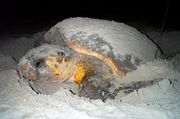Onslow Beach: Difference between revisions
imported>Stephen Ewen |
imported>Stephen Ewen mNo edit summary |
||
| Line 1: | Line 1: | ||
[[Image:OnslowBeachMilitaryExerciseGallery.png|thumb|340px|right|U.S. Military exercises conducted at Onslow Beach. Click on the image to be brought to a gallery.]]__NOTOC__ | [[Image:OnslowBeachMilitaryExerciseGallery.png|thumb|340px|right|U.S. Military exercises conducted at Onslow Beach. Click on the image to be brought to a gallery.]]__NOTOC__ | ||
'''Onslow Beach''' is an 11-mile (17.7 kilometer) stretch of undeveloped beach along the [[Atlantic Ocean|Atlantic]] coast, located in Onslow County, in southeastern [[North Carolina]]. It is primarily used as amphibious training grounds for the [[Marine Corps Base Camp Lejeune]], of which it is part. The beach additionally supports the recreational needs of the Camp Lejeune community, as well to the surrounding community to the extent possible. The beach is also home to two [[endangered species]], each sustained by a fragile ecosystem. | '''Onslow Beach''' is an 11-mile (17.7 kilometer) stretch of undeveloped beach along the [[Atlantic Ocean|Atlantic]] coast, located in [[Onslow County]], in southeastern [[North Carolina]]. It is primarily used as amphibious training grounds for the [[Marine Corps Base Camp Lejeune]], of which it is part. The beach additionally supports the recreational needs of the Camp Lejeune community, as well to the surrounding community to the extent possible. The beach is also home to two [[endangered species]], each sustained by a fragile ecosystem. | ||
==Usages: military and recreational == | ==Usages: military and recreational == | ||
Revision as of 21:57, 23 May 2007
Onslow Beach is an 11-mile (17.7 kilometer) stretch of undeveloped beach along the Atlantic coast, located in Onslow County, in southeastern North Carolina. It is primarily used as amphibious training grounds for the Marine Corps Base Camp Lejeune, of which it is part. The beach additionally supports the recreational needs of the Camp Lejeune community, as well to the surrounding community to the extent possible. The beach is also home to two endangered species, each sustained by a fragile ecosystem.
Usages: military and recreational
Onslow Beach as a military training location began with a search in late 1940 and early 1941 at Marine Corps headquarters. With new requirments for manpower stemming from U.S. interests abroad during World War II, the Corp projected that a "new species" of units and defense battalions would be needed to garrison forward bases. The increased demand for manpower would also mean an increased need for training facilities. A search along the U.S. east coast ensued.
One among several of the chosen sites was Onslow County North Carolina's New River area, which a military World War II historian described as "111,170 acres of water, coastal swamp, and plain, theretofore inhabited largely by sand flies, ticks, chiggers, and snakes." After the United States Congress funded construction for what is not Camp Lejeune on 15 February 1941, it activated less then three months later as a tent camp. Since then, the beach has been used by the U.S. Marine , Navy, and Army for various training exercises, particularly amphibious exercises and landings.[1] During times when no exercises are being conducted, the beach is popular for fishing, sunbathing, and shell collecting, especially during warmer months. On Memorial Day and Labor Day weekends, an estimated 2,000 people visit Onslow Beach.[2]
Endangered wildlife

Camp Lejeune conducts one of the preeminent fish and wildlife management programs within United States Department of Defense, and all wildlife at the beach is carefully managed to allow continued military usages of the beach.[3] Two endangered species, one animal and one plant, reside at Onslow Beach. The first known instance of successful nesting of a green sea turtle (Chelonia mydas) north of Florida occurred in 1980 at the beach. The specimen deposited 819 eggs in five nests. Tagged, she returned to the same stretch of the beach five years later to deposit 893 eggs, again in five nests. Today, sea turtles are known to habitually nest at the beach.[4] During their nesting season, from May through October, sea turtle eggs are daily collected from a one-mile stretch of the beach and placed in an incubator. The turtles are released after hatching.[5] Many other nests are cordoned off.
A U.S. federally protected annual plant, Seabeach amaranth (Amaranthus pumilus), grows on the beach's dunes and overwash flats.[6]
Restoration
As with most beaches that support important human and wildlife activity, restoration efforts to counter natural erosion are an ongoing effort. In September 2005, Hurricane Ophelia took an especial toll, not only causing significant erosion but nearly destroying the beach's historic Riseley Pier.
References
- ↑ Henry I. Shaw, Jr. Opening Moves: Marines Gear Up for War. Marines in World War II Commemorative Series. Available at: http://www.nps.gov/archive/wapa/indepth/extContent/usmc/pcn-190-003115-00/index.htm.
- ↑ Lance Cpl. Rebekka S. Heite, MCAS New River. "Life's a beach at Onslow Beach, N.C." Marine Corps News, 16 May 2007. Available at http://www.marines.mil/marinelink/mcn2000.nsf/lookupstoryref/20075185112.
- ↑ "Endangered Species Award Nomination, Natural Resources, Large Installation, Marine Corps Base Camp Lejeune, North Carolina." Defense Environmental Network & Information eXchange. Available at https://www.denix.osd.mil/denix/Public/News/OSD/SecDef00/NR/Camplejeune/camplejeune.html.
- ↑ Peterson, et al. "Tagged Green Turtle Returns and Nests Again in North Carolina". Marine Turtle Newsletter, 35:5-6, 1985.
- ↑ "Statement of Major Edward Hanlon, Jr., United States Marine Corps, Commanding General, Marine Corps Base Camp Pendleton, Before the Senate Armed Service Committee Subcommittee on Readiness and Management Support on 20 March 2001". United States Senate. Available at http://armed-services.senate.gov/statemnt/2001/010320eh.pdf.
- ↑ "Endangered and Threatened Wildlife and Plants; Amaranthus pumilus (Seabeach Amaranth) Determined To Be Threatened". Department of the Interior, Fish and Wildlife Services Division of Endangered Species (April 7, 1993, 50 CFR Part 17, RIN 1018-AB75). Available at http://www.fws.gov/endangered/r/fr93498.html.


